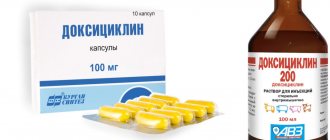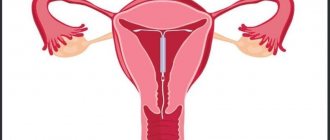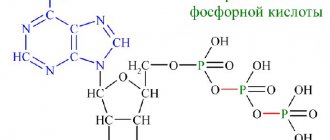Mechanism of action
The drug affects bacterial DNA by blocking DNA gyrase. As a result, the causative agent of the infectious disease dies. Abactal has an antimicrobial effect due to the presence of a fluorine atom in its chemical composition.
The drug affects both bacteria in the dormant stage and actively dividing cells.
- When taking Abaktal tablets, the medicine is absorbed and ends up in the systemic circulation. The drug reaches its highest concentration in the blood after 1.5 – 2 hours.
- The degree of binding of the drug to proteins is approximately 30%.
- Abaktal is found in saliva, sputum, bronchial secretions, amniotic fluid, prostate, bones.
- Abkatal is metabolized in the liver, the remaining drug is excreted by the kidneys after 8 hours with a single dose and 12 hours after repeated doses.
- Traces of Abaktal are detected in urine for 3-4 days after the last dose.
- The presence of renal failure in the patient does not affect the elimination time and plasma concentration of the drug.
- The presence of liver failure increases the half-life of Abaktal by two or more times. In this regard, the doctor must adjust the frequency of taking the medication.
Composition and release form
Abaktal is presented in two formats:
Related articles Ciprofloxacin intramuscularly How can you replace safocid Bactericidal eye drops
| Concentrate for the preparation of intravenous solution | Pills | |
| Description | Transparent colorless liquid | White-yellow oval tablets |
| Pefloxacin mesylate concentration, mg | 400 per 5 ml | 400 per 1 piece. |
| Auxiliary components | Water, ascorbic acid, sodium bicarbonate, sodium metabisulfite, benzyl alcohol, disodium edetate | Carnauba wax, lactose monohydrate, macrogol, corn starch, talc, povidone, titanium dioxide, sodium carboxymethyl starch, hypromellose, colloidal anhydrous silica, magnesium stearate |
| Package | Ampoules of 5 ml, trays of 10 ampoules | Blisters of 10 pcs., 1 blister in a pack |
Indications for use
As indicated in the instructions for use, the indication for taking Abactal is the treatment of infectious diseases whose pathogens are sensitive to the drug:
- respiratory tract diseases:
- otitis;
- urinary system infections;
- certain STIs (chlamydia and gonorrhea);
- digestive system infections;
- skin lesions in the form of infected ulcers, burns, wound surfaces, abscesses);
- septic manifestations;
- infectious diseases in patients with immunodeficiency;
- measures to prevent nosocomial infections.
Reviews about the drug
Reviews about the drug are quite ambiguous and mixed. On the one hand, it was rated by both doctors and patients as one of the most effective antibacterial agents in its range.
It helps to significantly reduce or completely eliminate symptoms after the first use, even taking into account severe conditions.
On the other hand, many people mentioned multiple side effects in their reviews. The most common were from the gastrointestinal tract, central nervous system, and also in the form of allergies.
At the same time, taking medication often became impossible due to such manifestations.
Before using the drug, it is important to have an adequate consultation with your doctor, and also periodically appear to monitor your condition. In the case of a solution, constant inpatient monitoring of the patient is necessary.
Mode of application
- Abactal is used both separately from other drugs and in complex therapy with other antibiotics. The daily dose of the drug is 800 mg, usually a double dose of 400 mg is prescribed.
- When treating diseases of the urinary system, it is allowed to take the drug 1 tablet (400 mg) 1 time per day.
- When treating gonorrhea , a single dose of 800 mg is prescribed. The maximum permissible dose should be no more than 1.2 g per day.
- If the patient has liver failure , 400 mg of the drug is prescribed every 24-48 hours.
- Abactal in tablet form is recommended to be taken with food to reduce the likelihood of side effects. In this case, the tablets must be swallowed whole.
- Intravenous administration of the drug is carried out in the hospital after studying the reaction to Pefloxacin. Typically, infusion therapy is prescribed at 400 mg every 12 hours. To prevent excessive concentrations of the drug, the duration of administration should be 1 hour.
In conditions that threaten the patient's life, a single intravenous administration of 800 mg of the drug is possible at the initial stage of therapy.
- When performing surgical interventions , Abaktal is administered for prophylactic purposes before surgery (400-800 mg of the drug).
- If the patient has liver failure , the dose of the drug is calculated based on his body weight and is 8 mg per 1 kg of weight.
- In older patients, the dosage is determined taking into account concomitant pathologies.
The effect of treatment with Abactal should be assessed no earlier than 72 hours after the start of therapy.
Abaktal price, where to buy
You can find Abaktal tablets, the price of which varies in Moscow pharmacies, using the website of the Federal Information Service. The cost of 400 mg tablets No. 10 ranges from 250 to 350 rubles.
- Online pharmacies in RussiaRussia
- Online pharmacies in UkraineUkraine
- Online pharmacies in KazakhstanKazakhstan
ZdravCity
- Abactal tablets p.p.o. 400 mg 10 pcs Lek dd
Pharmacy Dialogue
- Abaktal tablets 400 mg No. 10Lek
Europharm* 4% discount using promo code medside11
- Abaktal 400 mg 10 tablets DD
show more
Pharmacy24
- Abaktal 400 mg No. 10 tablets Lek pharmaceutical company d.d., Slovenia
- Abaktal 400 mg 5 ml No. 10 concentrate for solution Lek pharmaceutical company d.d., Slovenia
PaniPharmacy
- Abaktal ampoule Abaktal solution d/in. 400mg amp. 5ml No. 10 Slovenia, Lek
- Abaktal tablets Abaktal tablets. 400 mg No. 10 Slovenia, Lek
show more
Side effects
When using the drug Abactal, some side effects may occur:
- From the central nervous system it is manifested by dizziness, convulsions, headache, anxiety, hallucinations, sleep disturbance, tremor, depression.
- From the digestive system in the form of decreased appetite, nausea, diarrhea, changes in taste, dyspepsia, vomiting. Sometimes there is a transient increase in bilirubin and alkaline phosphatase levels.
- From the urinary system it manifests itself in the form of crystalluria, interstitial nephritis, and hematuria.
- From the musculoskeletal system in the form of tendinitis, myalgia, arthritis. There have been known cases of Achilles tendon ruptures.
- Phlebitis may occur at the injection site.
- There is a risk of immediate allergic reactions.
- Transient changes in the erythrocyte or leukocyte formula .
Contraindications
Contraindications for Abaktal are:
- Age less than 18 years;
- Lactation;
- Pregnancy;
- Hypersensitivity.
Also, the medication should be used with extreme caution by those people who have disorders of the central nervous system, renal failure, or severe liver failure.
Overdose
An overdose of the drug can be manifested by confusion, vomiting, nausea, and sometimes the appearance of hallucinations. If the dose is exceeded many times, there is a risk of developing convulsions, loss of consciousness, and sometimes coma.
In case of an overdose of the drug, the patient must be taken to a poison control center. To provide first aid, it is necessary to rinse the stomach, give an enema and give a sorbent.
The use of hemodialysis in case of an overdose of Abactal is considered ineffective.
Drug interactions
- It is not recommended to take Abaktal together with drugs from the antacid (Maalox, Almagel). If there is a need for therapy with these drugs, the interval between taking them should be at least 2 hours.
- If Abaktal is prescribed together with antihistamines , the frequency of taking the antibiotic increases, since its circulation time in the blood plasma increases.
- When pefloxacin and aminoglycosides , their effect is enhanced, so the dosage of aminoglycosides must be reduced. Also, when Abaktal is combined with beta-lactam antibiotics, Rifampicin and Fosfomycin, the effect of the latter may be enhanced.
- When Abaktal interacts with NSAIDs, theophylline and caffeine, their metabolism decreases, as a result of which the concentration of these drugs in the blood and central nervous system may increase.
- Abactal can reduce the prothrombin index, so patients taking anticoagulants need to monitor their blood clotting levels.
- Parallel use of Abaktal with Cimetidine causes an increase in T1/2 of pefloxacin.
- Taking antacids containing aluminum, magnesium, iron and zinc-containing drugs reduces the absorption rate of Abaktal, so the interval between the use of these drugs should be at least 2 hours.
- The interaction of quinolones and cyclosporine leads to an increase in creatinine levels in the blood. However, taking Pefloxacin with metronidazole is possible.
- When taking Tetracycline or chloramphenicol with Abactal, the effect of these drugs may be reduced.
- Prescribing glucocorticosteroids during Abactal therapy increases the risk of developing tendinitis and damage to the Achilles tendon.
Abactal in the form of an injection solution cannot be mixed with saline solution.
Alcohol compatibility
The following table provides information regarding the possibility of taking Abaktal while drinking alcohol.
| Allowed | Forbidden |
|
|
To avoid harm to health, it is necessary to refrain from drinking alcohol for the entire period of treatment with Abactal.
special instructions
The solution in ampoules is used only in hospital settings, as it has a pronounced and rapid effect and side effects.
Since photosensitivity is present among the side effects, the patient must avoid UV radiation during the treatment period and 6 days after it.
If an allergic reaction occurs, a disturbance in the functioning of the central nervous system, or tendinitis is likely to develop, then the medication in therapy is discontinued and an analogue is selected.
Tendinitis most often develops after taking fluoroquinolones in:
- Patients over 60 years old;
- In case of renal failure;
- During dialysis;
- For dyslipidemia;
- During GCS therapy.
To prevent the full development of the pathological condition, the patient is warned in advance about the symptoms of the drug, upon manifestation of which the use of the medication must be discontinued. At the same time, the load on the affected limb is eliminated. Naturally, the patient will need to urgently visit a doctor.
When testing urine for glucose using the copper reduction technique, the results may be false positive. Therefore, instead of the copper sulfate method, the enzymatic method is used.
Abactal can be used with beta-lactam antibiotics, metronidazole, rifampicin, vancomycin. Caution must be exercised during simultaneous therapy with isoniazid and perfloxacin.
Since the drug often has manifestations from the central nervous system, when driving a vehicle or other complex mechanism, it is necessary to exercise maximum caution, or even better, to abandon such activities for the duration of therapy.












